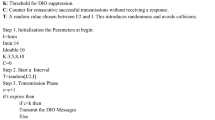Abstract
This paper presents a new group key management protocol, CKC (Code for Key Calculation) for secure IP multicast. In this protocol which is based on logical key hierarchy, only the group key needs to be sent to new member at join. Then, using the group key current members and the new member calculate the necessary keys by node codes and one-way hash function. A node code is a random number assigned to each node to help users calculate necessary keys. Again, at leave server just sends the new group key to the remaining members. By this key, members calculate necessary keys using node codes and one-way hash function. The security of the keys is based on one-wayness of hash function. The results show that CKC reduces computational and communication overhead, and message size largely at join without increasing them at leave.
Similar content being viewed by others
References
Jiang, B., & Hu, X. (2008). A survey of group key management. In 2008 international conference on computer science and software engineering (Vol. 3, pp. 994–1002), Dec. 2008. doi:10.1109/CSSE.2008.1282.
Wallner, D., Harder, E., & Agee, R. (1999). Key management for multicast: issues and architectures. National Security Agency, RFC2627.
McGrew, D. A., & Sherman, A. T. (2003). Key establishment in large dynamic groups using one-way function trees. IEEE Transactions on Software Engineering, 29(5), 444–458. doi:10.1109/TSE.2003.1199073.
Je, D., Seo, S., Park, Y., & Lee, J. (2010). Computation-and-storage-efficient key tree management protocol for secure multicast communications. Computer Communications, 33(2), 136–148. doi:10.1016/j.comcom.2009.08.007.
He, Z., & Li, Y. (2008). Dynamic key management in a user hierarchy. In 2nd international conference on anti-counterfeiting, security and identification, ASID 2008 (pp. 298–300), Aug. 2008. doi:10.1109/IWASID.2008.4688404.
Kwak, D., Lee, S., & Kim, J. (2006). An efficient LKH tree balancing algorithm for group key management. IEEE Communications Letters, 10(3), 222–224. doi:10.1109/LCOMM.2006.1603391.
Lu, R., Lin, X., Ho, P., Shen, X., & Cao, Z. (2008). A new dynamic group key management scheme with low rekeying cost. In Wireless communications and networking conference, WCNC 2008 (pp. 3243–3248), April 2008. New York: IEEE Press. doi:10.1109/WCNC.2008.566.
Nemaney Pour, A., Kumekawa, K., Kato, T., & Itoh, S. (2007). A hierarchical group key management scheme for secure multicast increasing efficiency of key distribution in leave operation. Computer Networks, 51(17), 4727–4743. doi:10.1016/j.comnet.2007.07.007.
Lin, J., Lai, F., & Lee, H. (2005). Efficient group key management protocol with one-way key derivation. In Proceedings of the IEEE conference on local computer networks 30th anniversary (LCN’5) (pp. 336–343), Nov. 2005. doi:10.1109/LCN.2005.61.
Author information
Authors and Affiliations
Corresponding author
Rights and permissions
About this article
Cite this article
Hajyvahabzadeh, M., Eidkhani, E., Mortazavi, S.A. et al. An efficient group key management protocol using code for key calculation: CKC. Telecommun Syst 51, 115–123 (2012). https://doi.org/10.1007/s11235-011-9421-8
Published:
Issue Date:
DOI: https://doi.org/10.1007/s11235-011-9421-8




